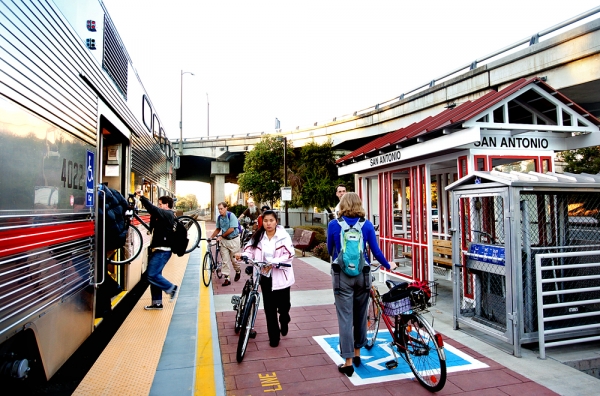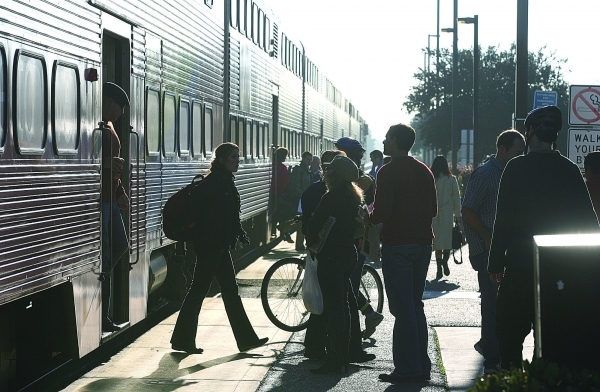For years, Palo Alto leaders have insisted that the city must come up with a plan to separate the railroad tracks from crossing streets to accommodate an expected surge in Caltrain riders.
But as Caltrain moves closer to adopting its own growth plan, the agency is considering two concepts that could require the construction of four tracks over a large section of Palo Alto — a project that could significantly disrupt local plans for what's known as "grade separation."
Caltrain's business plan, which aims to guide the rail system's evolution between now and 2040, projects a significant spike in ridership, fueled by the agency's pending electrification project (which will boost the number of trains) and its planned expansion to downtown San Francisco. The two projects are predicted to boost the ridership numbers from the current level of 62,000 daily riders, to 161,000 in the "baseline" scenario, 185,000 in the "moderate-growth" scenario and to 207,000 in the "high growth" scenario.
While the baseline scenario wouldn't require any major infrastructure upgrades in the Palo Alto area (aside from Caltrain's pending electrification project), the other two scenarios would each require additional tracks to be built either in Palo Alto or elsewhere in northern Santa Clara County, like Mountain View, Caltrain's senior policy adviser Sebastian Petty told the City Council on Monday during a study session on the business plan.
The moderate-growth scenario would require the construction of a four-track station somewhere in northern Santa Clara County, Petty said. The agency's plans depict that station at the California Avenue stop, though Petty noted that the facility can also be built in downtown Palo Alto, at the San Antonio Road station in Mountain View, or at the Mountain View station.
The high-growth scenario could have an even more dramatic impact on the local rail corridor. According to the agency, it would need up to 15 miles of four-track segments along the corridor, including a possible segment in Palo Alto or Mountain View. The four-track segments would be necessary to accommodate the state's proposed high-speed rail system, which has been plagued in recent years by funding shortages, critical audits and waning political support.
Given these setbacks, Caltrain is in no rush to come up with design options for the moderate- and high-growth scenarios.
"We would likely not want to advance specific planning for those passing track further until high-speed rail reaches some clear milestones and it's clear they're coming and we'll be planning for their arrival into the corridor," Petty said.
Either option would have a major impact on Palo Alto's plan to separate the rail corridor from local streets, a project that the City Council also discussed Monday night (when it eliminated a citywide tunnel from its list of rail-redesign options) and for which it plans to select a preferred alternative by October.
Councilman Tom DuBois said he has some concerns about the prospect of building a four-track segment in northern Palo Alto or by California Avenue. The city, he noted, has encountered significant constraints in pursuing its own grade separation plans, including the San Francisquito Creek and the iconic El Palo Alto redwood tree. The San Antonio Road station has a wider right-of-way and presents a much better opportunity for infrastructure improvements, he said.
For Palo Alto, Caltrain's evolving plans for infrastructure improvements are both a potential obstacle and a blessing. On one hand, the agency's plans to construct passing tracks or a new station could have significant ramifications on the city's grade-separation plans, with potential impacts on project costs and needed right-of-way acquisitions.
On the other hand, Caltrain officials expressed on Monday a new willingness to help Palo Alto and other cities implement grade separations — an approach that was welcomed by council members.
The business plan considers potential grade-separation projects up and down the corridor and concluded that they would collectively cost between $8.5 billion and $11 billion to implement. Caltrain doesn't currently have the funding to make these projects a reality, Petty said.
Even so, he told the council that grade separations are an important consideration in Caltrain's plans for needed infrastructure investment. The agency, he said, is "on the cusp of a change" in how it looks at grade-separation projects, which in recent years have been spearheaded by local jurisdictions and have largely been limited to San Mateo County.
"We are suggesting that there does need to be a corridorwide look at grade separations," Petty said.
Petty said that by working together, the various cities can be more effective in lobbying for state and federal funding sources. Given that neither Caltrain nor local cities have anywhere close to the needed funding, a "layer cake" approach with multiple sources (such as local, state and federal agencies) would be required to make these projects a reality. He noted that individual grade-separation projects have not had success in acquiring federal funding.
"We hope that by acting as a corridor we'll be able to leverage significantly larger amounts of state funding than currently is available for grade separations," Petty said.
In addition to finding funds for long-term infrastructure projects, Caltrain is also looking for a more immediate revenue influx to support its growing operations. The Peninsula Corridor Joint Powers Board of Directors, which oversees Caltrain, is now considering going to the voters with a tax measure in 2020.
Councilwoman Liz Kniss, a former member of the Caltrain board, noted that the agency currently doesn't have dedicated funding. Its funding mostly comes from fares and contributions from the three counties that Caltrain serves: San Francisco, San Mateo and Santa Clara.
"Long term, I hope (the measure) goes to the voters and I hope it's structured in such a way that it has a chance of passing," Kniss said.
Related content:




Comments
Rex Manor
on May 16, 2019 at 2:20 pm
on May 16, 2019 at 2:20 pm
Grade separations exist to make drivers lives modestly easier.
Caltrain should spend its money on making riders lives much better.
For example,
$8Billion could be used to buy enough trainsets to offer service every 10 minutes.
$8Billion would be money enough to connect Caltrain to Bart in Fremont.
$8Billion would be enough to electrify caltrain down to gilroy and maybe even to Monterey.
Grade separations dhould be paid with highway money which is easy to get -- not rail or transit money which is much, much harder.
Registered user
Jackson Park
on May 16, 2019 at 3:00 pm
Registered user
on May 16, 2019 at 3:00 pm
I'm skeptical about the calculations for expected ridership - they seem way to high. Perhaps we could use light rail as an example of failed projections for ridership.
Dumping more money into archaic technology like rail seems like a bad idea. Autonomous vehicles and remote working will likely change the needs for rail in the next 5-10 years.
Sylvan Park
on May 16, 2019 at 4:09 pm
on May 16, 2019 at 4:09 pm
Beware of Palo Alto pushing the impacts off to Mountain View
At best the impacts of all kinds physical, visual, and funding should each be equally shared.
I agree with the above comment that work from home will dramatically cut the needs for most commutes.
I also think High Speed Rail up the the peninsula will never happen.
Registered user
another community
on May 16, 2019 at 7:16 pm
Registered user
on May 16, 2019 at 7:16 pm
The Federal Government is talking about dropping its support of CA High Speed Rail (probably because we are Democrats, not for any objection to the idea), so I agree with Rodger that HSR is unlikely.
As for the chances that "[a]utonomous vehicles and remote working will likely change the needs for rail in the next 5-10 years", I'm not sure I agree; but they are up-coming alternatives.
Registered user
another community
on May 16, 2019 at 7:51 pm
Registered user
on May 16, 2019 at 7:51 pm
Electrification of the system will not only allow for more frequent train service, it will also mean faster train service, any maybe more cars per train. Even if the "'baseline' scenario" ridership estimate (161,000 daily riders) is high, the cost of electrification and new train systems may still be justified, even without HSR.
Light rail projections vs light rail actual daily riders, however, show that predicting transportation usage has a poor track record. (Sorry, I could not resist the pun.)